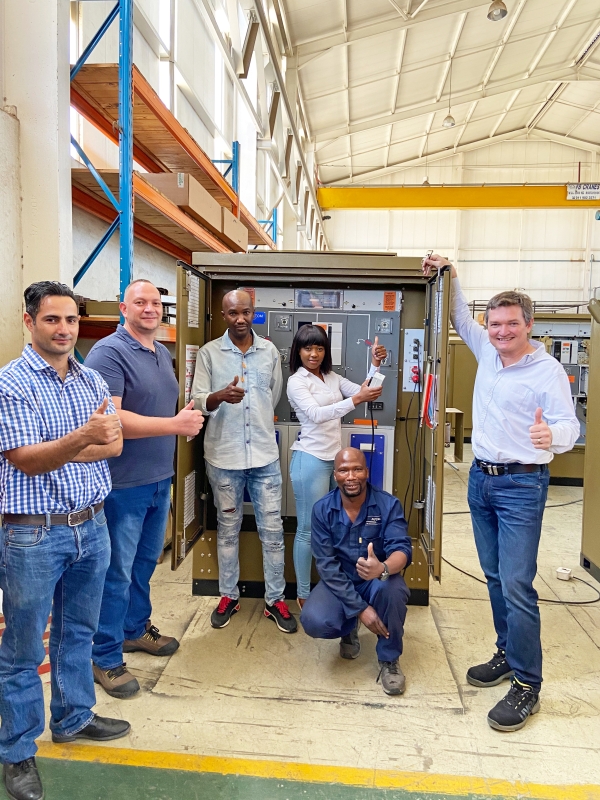ACTOM MV Switchgear has successfully carried out internal arc testing of its RMV ring main unit at the SABS National Electrical Test Facility’s (NETFA) recently refurbished High Power test laboratory.
The tests on the RMV ring main unit, which was housed in an outdoor steel kiosk, were conducted in late-September this year in accordance with the SANS/IEC 62271-202 standard to achieve an internal arc classification of IAC-AB for an arc fault current of 20kA and duration of 0.5 seconds.

Posing in front of a RMV ring main unit in MV Switchgear’s plant are (from left) Engineering Draughtsperson Victor Ferreira; Engineering Manager Piet Ferreira; Contracts Engineer Lucky Sengwayo; Technical Sales Consultant Linky Mdaka; Foreman James Schoeman and Technology Development Specialist Rhett Kelly.
“This classification provides a classified level of safety in the event of an internal failure to both authorised operators and the general public, as required by the SA National Standard SANS 1874 for ring main units,” said Rhett Kelly, MV Switchgear’s Technology Development Specialist.
“Two tests were involved. One, designated IAC-B for the general public, had to be carried out with the kiosk doors closed, while the other, IAC-A for authorised personnel, was performed with the doors open,” he explained.
Greg Whyte, MV Switchgear’s Design & Development Manager, commented: “What makes this test unique for ACTOM and the industry is that the arc initiation point was within the switching compartment of the ring main unit, in contrast to internal arc testing we carried out previously, where the arc initiation point was located in the cable termination compartment.
“An important implication of initiating the arc fault in the switching compartment is that the fault is a full three-phase fault at 100% of the short circuit current rating, as opposed to a phase to phase fault at 87% of the rated short circuit current rating, as applicable to arc faults initiated in the cable compartment, where outer cone separable connectors are used,” he said.
The ring main units used for testing had to be specially manufactured with the fault wire required for the arc initiation located inside the gas tank.
MV Switchgear’s latest testing of its RMV ring main unit were the first tests performed since the NETFA High Power test laboratory, which had been out of service for many years, was returned to service recently after undergoing a comprehensive refurbishment of much of its test equipment this year. The refurbishments were performed jointly by ACTOM ‘s Marthinusen & Coutts and ACTOM Turbo Machines (See story on Pg 21).
“We are delighted that the SABS NETFA High Power test laboratory is up and running again, as the absence of any suitable alternative test facilities in South Africa meant that internal arc testing over the last number of years had to be carried out overseas at significantly higher cost,” said Greg.
Rhett is an active member and task force leader of the IEC maintenance team 29 (MT29) responsible for the IEC 62271-202 standard to which the tests were carried out. He was also a task force leader on the working group 38 (WG38) responsible for the new IEC technical report (IEC 62271-312) providing guidance on the transferability of type tests carried out on equipment designed and manufactured in accordance with IEC 62271-202.
“The new IEC 62271-312 document, apart from providing for other options as agreed between manufacturer and user, can be used for the transferability of type tests performed on one or more prefabricated substations with a defined set of ratings and arrangement of components to another prefabricated substation with a different set of ratings or different arrangement of components. It supports the selection of appropriate representative test objects for that purpose in order to optimise the type testing procedure for a consistent conformity assessment,” Rhett said.
“For example, the internal arc tests carried out on our 3-way ring main unit can be transferred, without further testing being required, to a 4-way ring main unit housed in a larger kiosk, provided the conditions of IEC 62271-312 are fulfilled,” he explained.
“Following on from the publication of IEC 62271-307, which provides guidance for the extension of validity of type tests carried out on medium voltage metal-enclosed switchgear and controlgear, this concept provides a sound technical basis to optimise the number of type-tested variations and associated costs,” Rhett concluded.
The RMV ring main unit, MV Switchgear’s first co-developed gas-insulated ring main unit on offer in the local market, forms part of a range of non-extensible and extensible secondary distribution medium voltage switchgear for use in miniature substations, outdoor kiosks and indoor substations.
The non-extensible RMV ring main units, typically used in miniature substations and outdoor kiosks, includes three or four primary functional units with switching devices available in various combinations as required for the “ring main” and tee-off functions and include a switch-disconnector, switch-fuse combination and circuit-breaker.
Available up to 24kV, the product was developed by MV Switchgear in conjunction with LS Electric, the industrial division of the South Korea-based multinational company LG Corporation.
